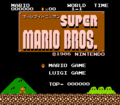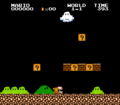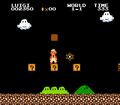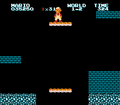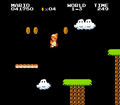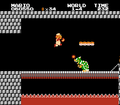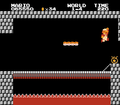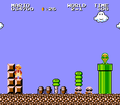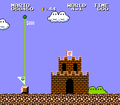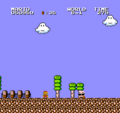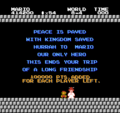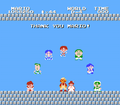All Night Nippon: Super Mario Bros.
The title of this article is official, but it comes from a non-English source. If an acceptable English source is found, then the article should be moved to its appropriate title.
Template:Infobox All Night Nippon Super Mario Bros. (オールナイトニッポン スーパーマリオブラザーズ) is an officially licensed retool of Super Mario Bros.: The Lost Levels, produced in 1986 for the Family Computer Disk System. This version is based on the Japanese radio program All Night Nippon, and it was given out in a contest on the show itself to celebrate the 20th anniversary of the program in the upcoming year. To get the game, listeners were told to send a postcard with interesting content. If it was not good enough, they would be entered into a raffle. Famicom Tsūshin (Famitsu) and Family Computer Magazine (Famimaga) also gave out 20 copies each to their readers in a lottery.[1] Most winners received their copy in February or March 1987. Initially, only 3000 copies were produced but a limited number were additionally created for mail order due to the high demand.[2] The game was published by Fuji TV, who would go on to publish Yume Kōjō: Doki Doki Panic, which was localized in the West as Super Mario Bros. 2. The game is a remix with most of the level designs adapted from Super Mario Bros. along with the likenesses of Japanese celebrities as sprite swaps. As such, there is no 2 Player Game but rather the option to play as Luigi with his unique physics.
Story
Translated from the instruction booklet[3]
One day, the peaceful All Night Nippon dream land Viva Kingdom where Mushrooms live was invaded by the tribe of the huge turtle Koopa, who possesses powerful magic. Said magical power was used to transform all the quiet Mushroom People into rocks, bricks and mikes among other forms. All Night Nippon personalities Miyuki Nakajima, the Tunnels, Kyōko Koizumi, Beat Takeshi, and the AB Brothers were also captured. What became of Sunplaza Nakano? Pitiable Sunplaza was fooled by Koopa's letter to his “Illusionary Business Prosperity” corner into visiting him. And he was changed into Koopa Tribe minion “OkaP”.
The only one who can undo this magic on the Mushrooms and revive All Night Nippon is the Viva Kingdom's own Princess Peach. She is presently in the hands of King Koopa.
Mario has stood up to help the personalities trapped in each world, defeat the Koopa Tribe, rescue Princess Peach, and rebuild the peaceful All Night Nippon dream land Viva Kingdom.
The Mario in the TV is an avid All Night Nippon listener like you. Only you can bring this adventure quest (expedition) to a conclusion.
Differences
Graphics
- World 1 was changed to nighttime.
- Most of the graphics are from The Lost Levels, although bricks and mountains are drawn like those in Super Mario Bros. Bricks are not shaded, and mountains have smooth slopes instead of jagged slopes. Cloud platforms were replaced with the Super Mushroom platforms but now with segmented stalks (which also replace the original Super Mushroom platform designs from the original Super Mario Bros.). Additionally, mikes replace the mushrooms found in the background.
- Little Goombas and Piranha Plants were changed to big-headed caricatures of DJ Sunplaza Nakano and are respectively called オカピー[4] (Okapī, "OkaP") and パックンオカピー[5] (Pakkun Okapī, "Piranha OkaP").
- The Starman was changed into a Hiranya (ヒランヤ[6]), a symbol popularized by a Japanese radio show called Young Paradise. The Hiranya also resembles the Star of David, a symbol of Judaism.
- The Nippon Broadcasting System, Inc. (the radio station that runs All Night Nippon) logo is found on the flag that is raised when Mario or Luigi enter a fortress. This logo is also found as the axe.
- The mushroom retainers were changed to Japanese celebrities that regularly appeared on the show, while Princess Peach is dressed as a traditional Japanese princess.
Their identities are as follows:[3]
- World 1: みゆき(中島みゆき) / Miyuki (Miyuki Nakajima)
- World 2: たかあき(とんねるず・石橋貴明) / Takaaka (Tunnels' Takaaki Ishibashi)
- World 3: のりたけ(とんねるず・木梨憲武) / Noritake (Tunnels' Noritake Kinashi)
- World 4: KYON²(小泉今日子) / KYONKYON (Kyōko Koizumi)
- World 5: たけし(ビートたけし) / Takeshi (Beat Takeshi)
- World 6: まっちゃん(ABブラザーズ・松野大介) / Matchan (AB Brothers' Daisuke Matsuno)
- World 7: ひでちゃん(ABブラザーズ・中山秀征) / Hidechan (AB Brothers' Hideyuki Nakayama)
- Worlds 8 & D: ピーチ姫 / Princess Peach
- Worlds A-C: Unknown (unlisted in the manual)
Level order
Most of the levels of the first eight worlds are from Super Mario Bros. but some are from The Lost Levels as shown here:
| All Night Nippon levels | Corresponding The Lost Levels | Notes |
|---|---|---|
| 5-3 | 4-3 | Originally 6-3 of VS. Super Mario Bros. |
| 5-4 | 2-4 | |
| 6-4 | 4-4 | |
| 7-2 | 6-2 | Originally 7-2 of VS. Super Mario Bros. |
| 7-3 | 6-3 | Originally 7-3 of VS. Super Mario Bros. |
| 8-4 | 8-4 | This is the only level ported from The Lost Levels that is neither played out of order nor have its design be completely altered for this game. |
The Hammer Brothers in 7-1 and 8-3 pursue Mario or Luigi like they do in those worlds in The Lost Levels.
Beating 8-4 will add a star to the title screen (up to twenty) and reveal Hard Mode in which all Okapī are replaced with Buzzy Beetles and all enemies move faster but players must start from 1-1 as there is no world select option. Hard Mode is not permanent as resetting returns the game to its normal difficulty. Like The Lost Levels, after beating 8-4 eight times (does not matter if with Warp Zones or not), the player gains access to edited versions of Worlds A, B, C, and D. Some of the levels are replaced with those from the first eight worlds of that game as seen here:
| All Night Nippon levels | Corresponding The Lost Levels | Notes |
|---|---|---|
| B-1 | 5-1 | Without the Warp Zone and the wind |
| B-3 | 3-3 | |
| C-3 | 7-3 | No wind |
| C-4 | 7-4 | |
| D-1 | 8-1 | This level had a major redesign with the Warp Zone and wind removed and parts of D-2 duplicated. There are two different flagpoles, both leading to D-2. |
Like VS. Super Mario Bros., every level features edits, such as the appearance of more enemies in 4-1, different maze solutions in 4-4 and 7-4, and changed locations of ?s and bricks. However, these changes are not the same as those found in VS. In addition, all Pakkun Okapī on the ground are green and all hanging ones, introduced in World A, are red but both behave like the red Piranha Plants in The Lost Levels. Two features from The Lost Levels have been removed. Poison Mushrooms have been replaced with regular power-ups. The removal of wind affects the difficulty of the courses they were found in. Super Springs, however, have been kept. World 9 does not exist if the player clears the game without using a Warp Zone. Attempting the Minus World glitch will have an effect similar to The Lost Levels, either sending the player to the pipe near the flagpole or back to 1-1.
Gallery
Fire Mario and a Hiranya
The mushroom platforms in World 1-2, as also seen in The Lost Levels
Fire Mario fighting a fake Bowser
The axe from the game
The heads by the pipe are Okapī while the head in the pipe is Pakkun Okapī.
Mario's small form
World 8-4 cleared
World D-4 cleared
Princess Peach sprite
Hidechan's sprite when Fire Mario
Okapī (castle)
Super Mushroom platform
Trivia
This trivia section is overly long. Please relocate any relevant information into appropriate sections and articles.
- Other games with a similar concept of Mario meeting Japanese celebrities were found on the Satellaview, with spiritual successors such as BS Super Mario USA, BS Super Mario Collection, and a version of Wario's Woods. Kaettekita Mario Bros. was another similar project.
- Luigi is shown to look exactly like Mario with a blue hat and overalls and a green shirt on the cover of this game. The cover is a modification of artwork for Mario no Daibōken, a 1986 single by Pony Canyon, a subsidiary of Fujisankei Communications Group like Fuji TV.[7] Pony Canyon also released a Super Mario Bros. promotional video under the same title that featured the same cover.[8] That video ends with "GO GO Mario!!", the side B song from that single which was the winner of All Night Nippon's nation-wide contest for lyrics to the Ground Theme. It was from this partnership that the idea for the game was born.
- ビバ王国[3] (Biba Ōkoku, Viva Kingdom) is named after "Viva Young", the slogan and subtitle of the All Night Nippon radio program. It is also the name of that show's newsletter.
- “幻の商売繁盛”のコーナー[9] ("Maboroshi no Shōbai Hanjō" no kōnā, "Illusionary Business Prosperity" corner) is a recurring segment in Sunplaza Nakano's show. He would perform a guerilla gig at a small business, usually a restaurant, and overwhelm it with customers.
- Okapī is a reference to Sunplaza Nakano's theme song in All Night Nippon.
- Pakkun Okapī and Princess Peach are represented by a "?" in the manual.
- This game marks the first time Princess Peach has ever done her hair up, predating Super Mario Sunshine by 16 years, and is also the first media to depict her in a different outfit from her usual attire.
- Despite Worlds A-C featuring a unique celebrity who remains the same throughout those worlds after being rescued, World D's ending still features the first seven celebrities rescued from the first seven worlds.
References
- ^ Famitsu #14, December 26, 1986 issue
- ^ Family Computer Disk System: Not for Sale. Retrieved February 20, 2021.
- ^ a b c All Night Nippon Super Mario Bros. instruction booklet, pages 6 and 7.
- ^ All Night Nippon Super Mario Bros. instruction booklet, page 12.
- ^ All Night Nippon Super Mario Bros. instruction booklet, page 13.
- ^ All Night Nippon Super Mario Bros. instruction booklet, page 10.
- ^ Mario's Big Adventure/GO GO Mario!!. VGMdb. Retrieved January 23, 2021.
- ^ NES Tunes (January 8, 2021). Nintendo VHS: Super Mario Bros.Promotion Tape: Mario's Adventure | All Night Nippon Famicom Warriors. YouTube. Retrieved January 23, 2021.
- ^ All Night Nippon Super Mario Bros. instruction booklet, page 6.

